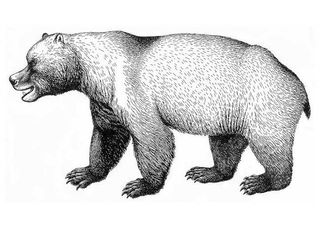Cavemen Accused of Wiping Out Cave Bears

Giant cave bears thought to have once dined on each other might have been driven to extinction by the advance of humanity, scientists now suggest.
Cave bears (Ursus spelaeus) are named after the places where their bones are often found — caves across Europe. These giants were roughly a third larger than modern grizzly bears, and while scientists previously thought cave bears were vegetarians, recent findings hinted they might also have consumed meat, and possibly even cannibalized each other.
Cave bear populations started to plummet in Europe 24,000 years ago, dying out roughly 20,000 years ago, back when ice dominated the Earth. The cause was unknown.
Breeding bears
Now an international team of scientists analyzing DNA in 17 newly identified fossils of cave bears has revealed the decline started 50,000 years ago, "much earlier than previously suggested, at a time when no major climate change was taking place, but which does coincide with the start of human expansion," said researcher Aurora Grandal-D'Anglade at the University of Coruña in Spain.
The scientists compared 59 DNA sequences from cave bear mitochondria — the powerhouses within their cells — with 40 modern and fossil DNA samples from brown bears (Ursus arctos) to find out why the former went extinct while the latter did not.
Their findings suggest that cave bear genetic diversity — a clue to how many there were — began declining 50,000 years ago. Other fossil evidence reveals they ceased to be abundant in Central Europe roughly 35,000 years ago. (Diversity of genes can provide indirect evidence for the number of breeding individuals, because with more bears mating more genes are thrown into the mix, and vice versa.)
Sign up for the Live Science daily newsletter now
Get the world’s most fascinating discoveries delivered straight to your inbox.
"This can be attributed to increasing human expansion and the resulting competition between humans and bears for land and shelter," Grandal-D'Anglade explained.
Cave bears vs. cavemen
Starting about 50,000 years ago, cave bears and other carnivores started receiving serious competition for these caves from cavemen.
"As humans became more effective at using caves, the number of places where cave bears could hibernate, which was essential to reproduction and everything else they did, started to decrease," Erik Trinkaus, an anthropologist at Washington University in St. Louis, told LiveScience.
When ice dominated the planet roughly 20,000 years ago, the combination of fewer caves for hibernation and significant reductions in the vegetation the animals largely depended on may have delivered "the 'coup de grace' for this species, which was already in rapid decline," Grandal-D'Anglade said.
In contrast, the brown bear may have survived until today precisely because they did not depend so heavily on caves.
"Brown bears rely on less specific shelters for hibernation," Grandal-D'Anglade said. "In fact, their fossil remains are not very numerous in cave deposits."
The scientists detailed their findings in the May issue of the journal Molecular Biology and Evolution.

